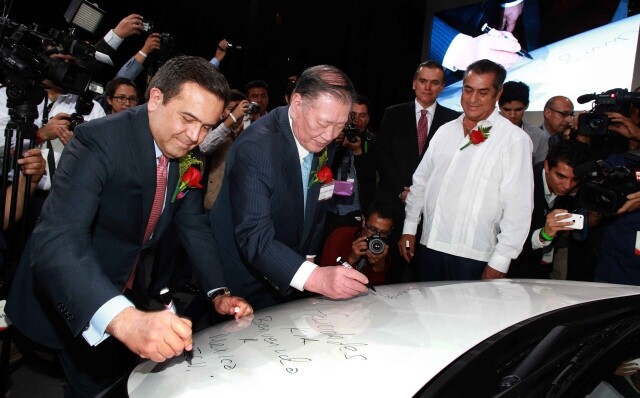hankyoreh
Links to other country sites 다른 나라 사이트 링크
Trump once again implies Canada’s exclusion from NAFTA

After US President Donald Trump suggested once again on Sept. 1 that Canada could be entirely excluded from the North American Free Trade Agreement (NAFTA), attention is focusing on the potential repercussions.
If Canada leaves NAFTA, the biggest impact is likely to be on the automobile industry. “Canada leaving the NAFTA would inevitably sow massive chaos in the automobile industry,” the Nihon Keizai Shimbun, a Japanese daily newspaper, reported on Sept. 2.
In 2017, global automakers manufactured more than 2.2 million automobiles in Canada, of which the majority – over 1.89 million – were exported to the US. In the same year, over 4.07 million automobiles were produced in Mexico, and more than 2.7 million of these were exported to the US.
If Canada is booted from NAFTA, sedans that are made in Canada and exported to the US will be subjected to a 2.5 percent tariff, while sports utility vehicles (SUVs) and trucks will be slapped with a 25 percent tariff.
The parts supply network that has come into being between the US and Canada across the Great Lakes would suffer a major shock as well. Manufacturing cars involves sending numerous car parts between American industrial cities such as Detroit and major Canadian cities such as Toronto. If Canada drops out of NAFTA, Canadian-made car parts that are exported to the US will face a tariff of 2.5 percent while American-made parts exported to Canada will face tariffs of around six percent. And as parts bounce back and forth across the border, tariffs will increase exponentially.
This also creates a serious dilemma for Kia Motors, which has set up operations in Mexico. The basic agreement that the US and Mexico reached on the revised version of NAFTA on Aug. 27 bolsters the “place of origin” rules for automobiles that enjoy a tariffs waiver. Previously, automobiles could be exported without tariffs if at least 62.5 percent of their parts were procured within the NAFTA zone, but the revised version bumps that up to 75 percent. Furthermore, between 40 and 45 percent of the parts must be made by workers who are paid at least US$16 an hour. That makes it tougher for Kia’s local office to export cars to the US.
Furthermore, Trump ordered officials at the end of May to review the idea of applying steep tariffs to automobiles imported to the US, and he tweeted at the end of June that the US was looking into applying a 20 percent tariff to imported automobiles. Since South Korea is currently exporting automobiles to the US tariff-free under the provisions of the Korea-US Free Trade Agreement (KORUS FTA), this measure, if adopted, would cause major havoc. Last year, 845,000 of the 2.53 million vehicles exported by South Korean automakers, or 33 percent, went to the US.
By Gil Yun-hyung and Hong Dae-seon, staff reporters
Please direct comments or questions to [english@hani.co.kr]

Editorial・opinion
![[Editorial] Does Yoon think the Korean public is wrong? [Editorial] Does Yoon think the Korean public is wrong?](https://flexible.img.hani.co.kr/flexible/normal/500/300/imgdb/original/2024/0417/8517133419684774.jpg) [Editorial] Does Yoon think the Korean public is wrong?
[Editorial] Does Yoon think the Korean public is wrong?![[Editorial] As it bolsters its alliance with US, Japan must be accountable for past [Editorial] As it bolsters its alliance with US, Japan must be accountable for past](https://flexible.img.hani.co.kr/flexible/normal/500/300/imgdb/original/2024/0417/6817133413968321.jpg) [Editorial] As it bolsters its alliance with US, Japan must be accountable for past
[Editorial] As it bolsters its alliance with US, Japan must be accountable for past- [Guest essay] Amending the Constitution is Yoon’s key to leaving office in public’s good graces
- [Editorial] 10 years on, lessons of Sewol tragedy must never be forgotten
- [Column] A death blow to Korea’s prosecutor politics
- [Correspondent’s column] The US and the end of Japanese pacifism
- [Guest essay] How Korea turned its trainee doctors into monsters
- [Guest essay] As someone who helped forge Seoul-Moscow ties, their status today troubles me
- [Editorial] Koreans sent a loud and clear message to Yoon
- [Column] In Korea’s midterm elections, it’s time for accountability
Most viewed articles
- 1‘Right direction’: After judgment day from voters, Yoon shrugs off calls for change
- 2[Editorial] Does Yoon think the Korean public is wrong?
- 3[Editorial] As it bolsters its alliance with US, Japan must be accountable for past
- 4Where Sewol sank 10 years ago, a sea of tears as parents mourn lost children
- 5Strong dollar isn’t all that’s pushing won exchange rate into to 1,400 range
- 6[Guest essay] Amending the Constitution is Yoon’s key to leaving office in public’s good graces
- 7Japan officially says compensation of Korean forced laborers isn’t its responsibility
- 8[News analysis] Watershed augmentation of US-Japan alliance to put Korea’s diplomacy to the test
- 9Korea ranks among 10 countries going backward on coal power, report shows
- 10US, Japan and China move to become self-sufficient in semiconductors